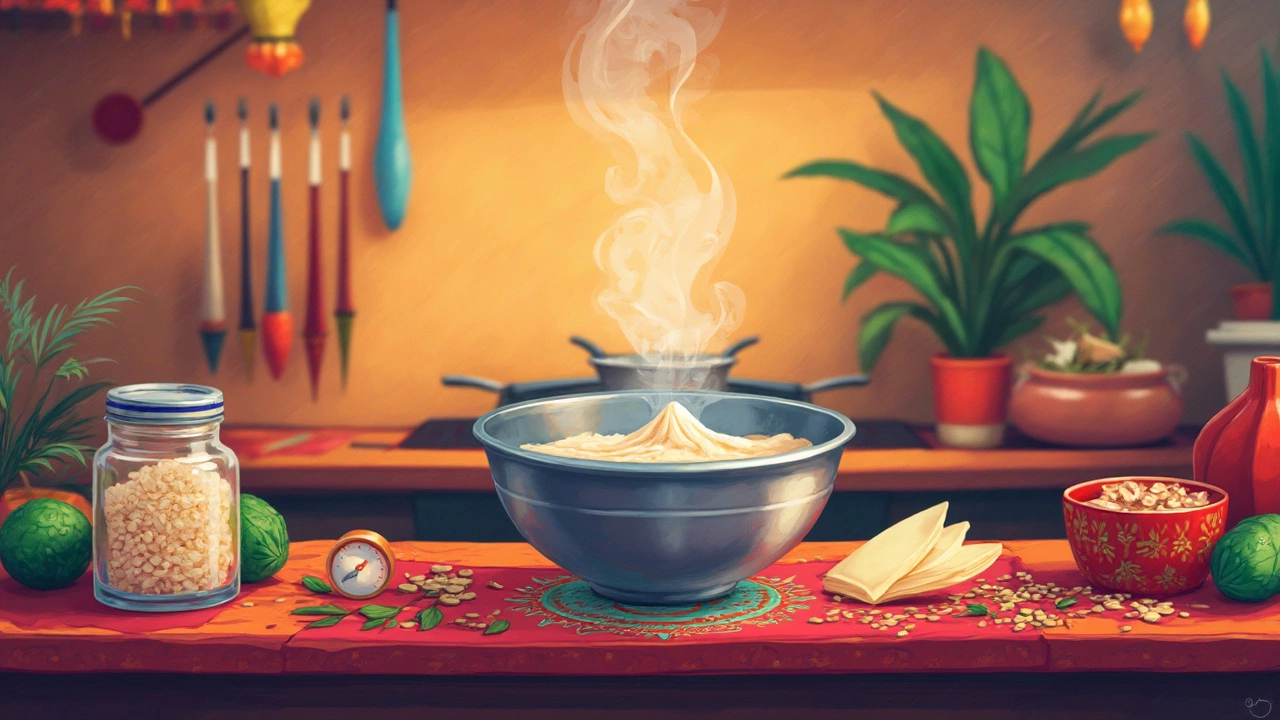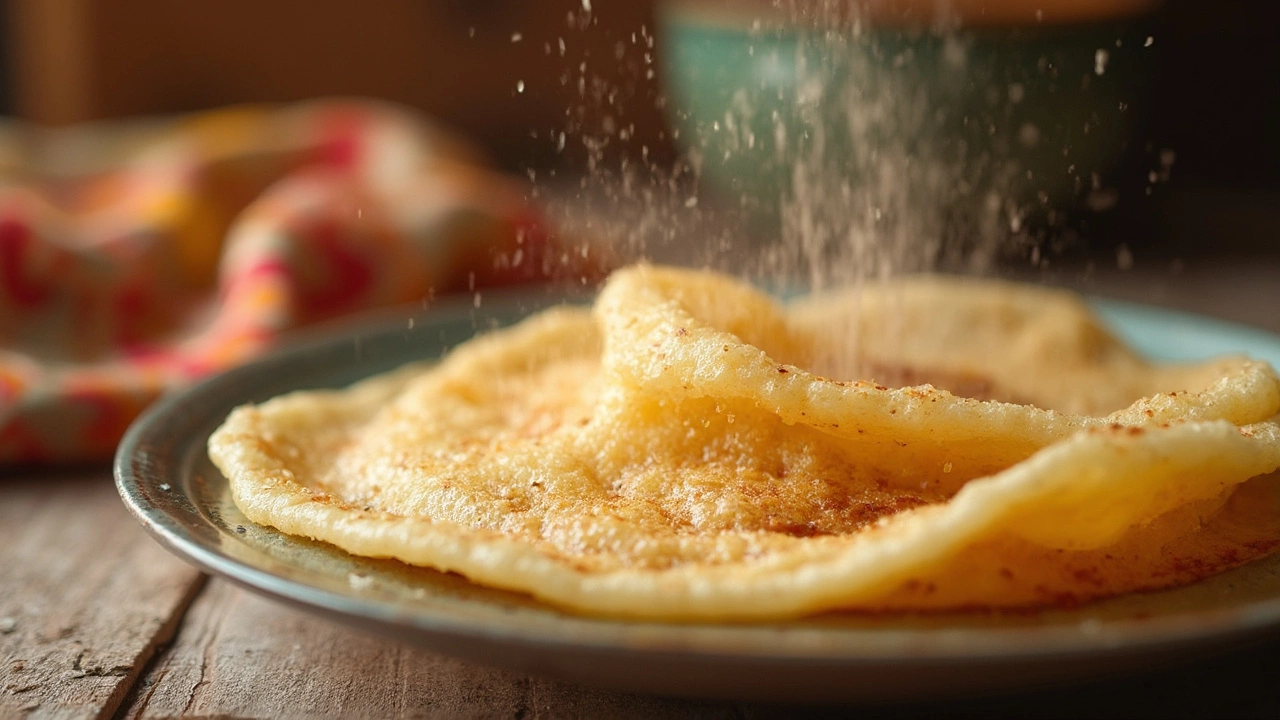Quickly Fermenting Dosa Batter: 4-Hour Method Without Yeast
 Feb, 15 2025
Feb, 15 2025
If you've ever craved crispy homemade dosas but didn't want to wait overnight for the batter to ferment, you're not alone. Luckily, there are ways to speed up the fermentation process without using yeast, and we're going to dive right into some of the best methods.
Fermentation of dosa batter usually takes between 8 to 12 hours at room temperature. But hey, modern problems require modern solutions, and here we've got a method that cuts this time to about four hours. So, what exactly helps speed things up? Let's explore the basics and some handy tricks!
Understanding Fermentation
Fermentation might sound like a science experiment, but it's actually a simple process that's been used in cooking for ages. At its core, fermentation is about creating the right environment for beneficial bacteria and yeasts to transform sugars into acids, gases, or alcohol. For dosa batter, it's all about getting those natural bacteria, mostly lactobacilli, to grow and work their magic, turning the batter from bland to tangy and fluffy.
Why is this so important? Well, without this natural fermentation, your dosas could end up more like bland pancakes. The flavor, texture, and even the nutritional profile of dosas improve with this natural fermentation process. It's like hitting the jackpot in dosa-making!
What's Happening in the Mix?
When you mix rice and lentils for dosa batter, the starches in the rice become food for the bacteria. These bacteria produce lactic acid, which gives that signature sourness while making the dosa batter rise and fluff up. Here's a neat fact: optimal temperatures speed up this process without any need for yeast.
"The key to quick fermentation lies mainly in controlling the environment around your batter," says Priya Joshi, author of 'The Art of Indian Cooking'. "A warm spot in your kitchen can be your best friend when trying to speed things up!"
Factors That Influence Fermentation
- Temperature: The warmer, the faster. Aim for about 30°C (86°F) to keep your batter cozy.
- Consistency: Too thick or too runny batter can impact growth. Go for a pancake-like consistency.
- Quality of ingredients: Fresher, well-sprouted lentils can catalyze the process.
While fermentation is slowly becoming a popular talk, the science behind it is not news. So next time you prepare your batter, think of it as a living system, where every element counts, but with some tricks, achieving quick fermentation might surprise you with tasty results!
Key Ingredients and Tips
To nail the perfect dosa batter in a short span, getting your ingredients just right is key. For those unfamiliar, the essential components of dosa batter are rice and urad dal (black gram lentils). Typically, you'd want a ratio of about 3:1 or 4:1 (rice to dal) to kick things off.
Using the right type of rice matters a lot, too. Try to get your hands on parboiled rice as it tends to speed up fermentation. If that’s not an option, any short-grain rice should do the trick.
Boosting Fermentation Naturally
You might be thinking, 'How do I naturally boost fermentation for quick results?' Here's where a couple of natural tricks come into play:
- Fenugreek Seeds (Methi): These little seeds are a fermenting powerhouse. You only need about a tablespoon during the soaking process; they not only aid fermentation but also add a nice flavor.
- Poha (Flattened Rice): Adding half a cup of poha when grinding your mix can drastically speed things up by adding more surface area for fermentation.
Water and Grinding
The water you use while grinding plays its part, too. Try using lukewarm water instead of cold, as it mildly helps in fermenting the dal and rice mixture quicker. The batter consistency matters, too – aim for a smooth, thick consistency, not too runny.
Flavoring Tips
If you want that traditional touch without compromising on time, add a pinch of salt at the final stage, just before setting it to ferment. It balances the flavors nicely and promotes even fermentation throughout the batter.
By paying attention to these basic ingredients and quick tips, you're setting yourself up for making dosas that are crisp on the outside and soft on the inside, without the overnight wait!

Temperature Hacks
Getting the temperature just right can make all the difference in fermenting dosa batter quickly. It's one of those things that isn't just nice to know but absolutely crucial when you want to shave hours off the process.
Warm Water for Mixing
One easy hack is starting off with warm water. When you're initially mixing rice and urad dal, use water that's slightly warm. This provides an ideal environment for natural bacteria to thrive, kicking off the fermentation faster. Just make sure it's not too hot; lukewarm like baby bath water is perfect.
Creating a Warm Environment
Next, let's talk about storage. Leaving the bowl in a warm place significantly accelerates fermentation. If your kitchen isn't warm enough, consider putting the bowl inside a switched-off oven with the light on. Another method is using an Instant Pot on the 'Yogurt' setting for a gentle and consistent warmth. This is particularly handy in colder climates where room temperatures can sabotage your efforts.
| Temperature (°C) | Approx. Fermentation Time |
|---|---|
| 30°C | 6-8 hours |
| 24°C | 8-10 hours |
| 18°C | 12-24 hours |
Insulate the Bowl
Another trick is keeping your batter bowl wrapped in a cozy blanket or a couple of thick towels. This keeps the warmth trapped, helping the good bacteria do their job. And if you have a bread proofing basket lying around, that works great too!
Give these temperature hacks a try, and you might find yourself with perfectly fermenting dosa batter faster than you thought. Whether it's warm water, the trusty stove light, or a snug blanket, these tricks can help you get that perfect fermentation bowl rolling in no time!
4-Hour Method Steps
Getting your dosa batter ready in just four hours might sound too good to be true, but with the right approach, it's completely doable. Here’s a foolproof method to help you get your dosas on the table faster than ever.
1. Start with Warm Water
Begin by soaking rice and urad dal in warm water. The warmth helps speed up the process, giving a head start to the fermentation. Keep it around 40°C if possible.
2. Use Fresh Ingredients
Blend your soaked rice and dal into a smooth batter, ensuring to incorporate a little bit of stored batter or a spoon of fenugreek seeds which naturally enhance fermentation. Fresh ingredients make a big difference in fermenting quickly.
3. Set the Right Temperature
If it’s not warm enough in your kitchen, use an oven or a yogurt maker to keep a consistent temperature. Aim for around 30°C to 35°C, as it’s the sweet spot for fast fermentation without yeast.
4. Keep It Covered
Cover the batter with a lid, but not tightly – you want air to get in and work its magic. A loose cover can help keep the warmth inside while allowing the fermentation gases to escape.
5. Add a Little Sugar
Adding a pinch of sugar can contribute to faster fermentation. It feeds the natural bacteria that aid in the process, getting your dosa batter ready in no time.
Simple Temperature Guide
| Temperature (°C) | Fermentation Time (hours) |
|---|---|
| 25 | 8-10 |
| 30 | 6-8 |
| 35 | 3-4 |
With these steps, you'll enjoy delicious dosas with the same authentic taste, just quicker and without yeast. Try it out next time you're pressed for time but craving this classic dish!